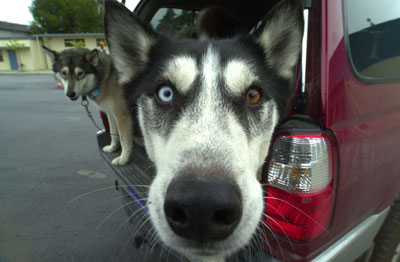
As the start of the 2003 Iditarod nears, many teams of huskies
are gearing up for the Alaskan cross-country sled dog race
– including the Huskies of R.O. Hardin Elementary School.
As the start of the 2003 Iditarod nears, many teams of huskies are gearing up for the Alaskan cross-country sled dog race – including the Huskies of R.O. Hardin Elementary School.
Fourth-grade students at the school have been researching the race, which begins Saturday, and will follow it via the Internet for the next few weeks. To help them learn more about the race, its participants and their dogs, a dog trainer brought her sled and three huskies to the school Tuesday to let the students see what the dogs are really like.
“These dogs like to run forever,” said Santa Cruz resident Jane Devlin, the dogs’ owner and trainer. “You have to be strong or they’ll run away from you.”
Four classes of fourth graders watched as Devlin harnessed the dogs to the sled, showing the students the harnesses and booties the dogs wear while running.
Students were taken aback by one dog – named Holy Toledo – who had one blue eye and one brown one. That’s common among huskies, Devlin said.
She went over the huskies’ bodies, detailing for the students why they are able to run in the snow – their long legs, long hair that includes two layers of fur and a furry, fluffy tail that they use to cover their face when sleeping in the snow.
“These dogs are bred to survive, not be with people,” Devlin said.
First run in 1973, the Iditarod – officially The Iditarod Trail International Sled Dog Race – covers more than 1,049 miles across central Alaska. The distance is a symbolic figure; the race is always more than 1,000 miles and 49 are added to signify Alaska’s place as America’s 49th state. The route usually goes from Anchorage to Nome, but a severe lack of snow is forcing a restart Monday from Fairbanks, far north of Anchorage.
Over 60 mushers – those who drive a dog sled or team of dogs – have entered the event. Mushers race 16 dogs the length of the race and are required to finish with at least five. (Dogs have been injured and even died along the route.) The fastest time was nine days, two hours, 42 minutes and 19 seconds in 1995. The slowest winning time was 20 days, 15 hours, two minutes and seven seconds in 1974.
Teachers said using the Iditarod as a classroom tool helps students learn about Alaska, the Internet and using a computer. Students in Susan Bessette’s class voted for the musher they think will win and made “gorp” – a mixture of high-energy foods, such as nuts and dried fruit – eaten by the mushers as a snack.
Students followed recipes to make the gorp, thus using math skills. They’re also rationing their gorp until the end of the race, as the mushers do.
Despite the cold environment, the huskies are well taken care of. They have to eat 2,500 calories per day, Devlin said, and mushers are required to carry two pounds of food and eight booties per dog at all times. There are 27 checkpoints along the route where dogs can be examined by veterinarians. Mushers even carry straw beds for the dogs to sleep on and take one mandatory 24-hour stop and two eight-hour stops.
The top 30 finishers receive part of the $600,000 purse – from $68,571 for first place to $1,429 for 30th. It costs almost $2,000 to enter a team.
For information on the race, go to www.iditarod.com.






